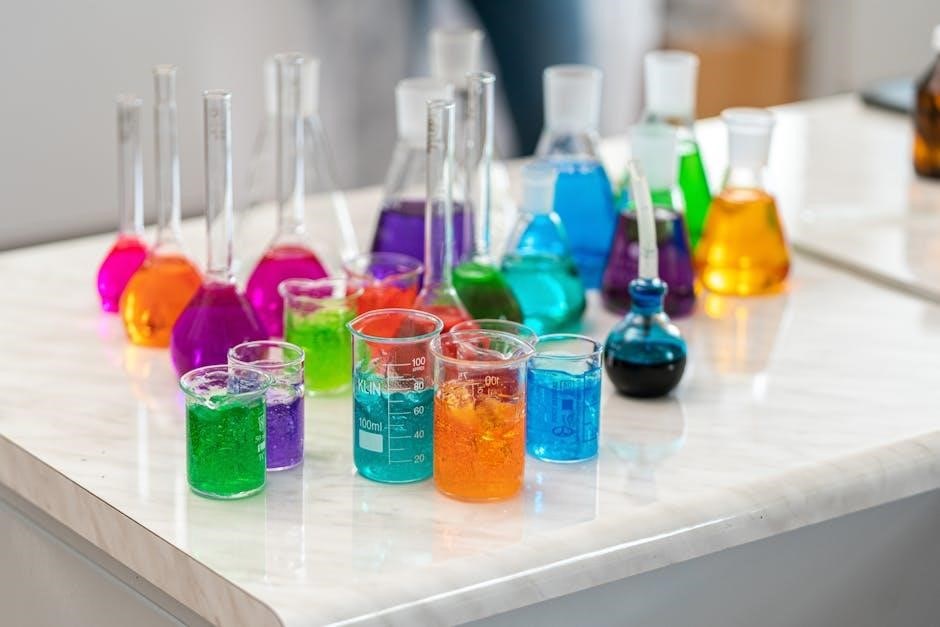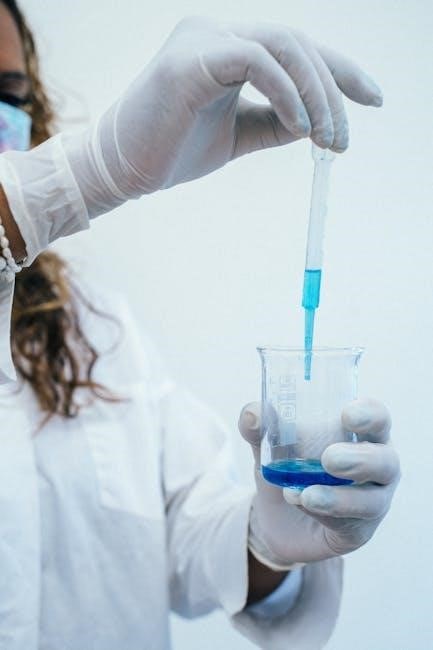Chemical reactions involve the transformation of matter, creating new substances through chemical changes. Understanding these processes is fundamental in chemistry, impacting fields like science, technology, and everyday life.
1.1 Definition and Importance
A chemical reaction is a process where substances (reactants) transform into new substances (products) through chemical changes. These reactions are fundamental in understanding chemistry, as they explain how matter interacts and transforms. Studying chemical reactions is crucial for advancements in science, technology, and solving real-world problems, making them a cornerstone of chemistry education and research.
1.2 Key Concepts in Chemical Reactions
Key concepts in chemical reactions include reactants, products, chemical equations, and coefficients. Reactants are the starting materials, while products are the resulting substances. Chemical equations represent reactions symbolically, with coefficients balancing the number of atoms. Understanding these concepts is vital for analyzing and predicting reaction outcomes, making them foundational for studying chemistry and its practical applications in various fields.

Basic Concepts
Chemical reactions involve elements and compounds, with reactants transforming into products. Understanding these foundational components and their roles is essential for analyzing reaction processes effectively.
2.1 Chemical Compounds and Elements
Chemical compounds are substances formed when elements combine in specific ratios. Elements are pure substances consisting of only one type of atom. For example, water (H₂O) is a compound made from hydrogen and oxygen elements. Understanding the difference between elements and compounds is crucial for analyzing chemical reactions and identifying reactants and products. This knowledge forms the foundation for studying chemical processes and transformations.
2.2 Reactants and Products
Reactants are the substances that undergo chemical change in a reaction, while products are the new substances formed. For example, in the reaction 2Na + Cl₂ → 2NaCl, sodium (Na) and chlorine (Cl₂) are reactants, and sodium chloride (NaCl) is the product. Understanding reactants and products is essential for analyzing chemical equations and tracking the transformation of matter during reactions. This concept is fundamental to chemistry and stoichiometry.
2.3 Chemical Equations and Coefficients
A chemical equation represents the reactants, products, and their proportions in a reaction. Coefficients, numbers placed in front of formulas, indicate the number of molecules involved. For example, in 2Na + Cl₂ → 2NaCl, the coefficient 2 shows two sodium atoms react with one chlorine molecule to form two sodium chloride molecules. Coefficients ensure the equation is balanced, making them crucial for stoichiometric calculations and understanding reaction ratios.

Types of Chemical Reactions
Chemical reactions are classified into five main types: combination, decomposition, single-replacement, double-replacement, and combustion. Each type follows distinct patterns, making classification essential for understanding reaction mechanisms and predicting outcomes.
3.1 Combination Reactions
A combination reaction occurs when two or more reactants combine to form a single product. The general form is A + B → AB. For example, sodium (Na) reacts with chlorine (Cl₂) to form sodium chloride (NaCl). These reactions are fundamental in chemistry, often involving elements or compounds. They are commonly seen in industrial processes and everyday phenomena, such as iron rusting or calcium oxide forming from calcium and oxygen.
3.2 Decomposition Reactions
A decomposition reaction involves a single compound breaking down into two or more simpler substances. The general form is AB → A + B. For example, water decomposes into hydrogen and oxygen (2H₂O → 2H₂ + O₂) when electrolyzed. These reactions often require energy input, such as heat or light, and are crucial in natural processes like digestion and industrial applications like cement production through limestone decomposition.
3.3 Single-Replacement Reactions
In a single-replacement reaction, one element displaces another from a compound. The general form is A + BC → AC + B. For example, zinc reacts with hydrochloric acid to produce zinc chloride and hydrogen gas (Zn + 2HCl → ZnCl₂ + H₂). These reactions often involve metals and acids, with the more reactive element replacing the less reactive one, releasing gases or solids in the process.
3.4 Double-Replacement Reactions
In double-replacement reactions, two compounds exchange ions to form new compounds. The general form is AB + CD → AD + CB. For example, potassium iodide (KI) reacts with lead nitrate (Pb(NO₃)₂) to form lead iodide (PbI₂) and potassium nitrate (KNO₃). These reactions often result in the formation of a precipitate, such as PbI₂, which is insoluble in water and settles out of the solution.
3.5 Combustion Reactions
Combustion reactions involve the burning of a substance, typically in the presence of oxygen, producing heat and light. The general form is fuel + oxygen → carbon dioxide + water. For example, methane (CH₄) burns to form CO₂ and H₂O. These reactions release energy and are essential in processes like respiration and fossil fuel burning, forming the basis of many industrial and biological systems.

Balancing Chemical Equations
Balancing chemical equations ensures the conservation of mass, with equal atoms of each element on both sides. Adjust coefficients to achieve equilibrium in reactants and products.
4.1 Importance of Balancing Equations
Balancing chemical equations is crucial for maintaining the conservation of matter. It ensures equal numbers of atoms for each element on both sides, adhering to the law of conservation of mass. Proper balancing allows accurate stoichiometric calculations, predicting reaction outcomes, and understanding chemical processes; It is essential for laboratory experiments, industrial manufacturing, and real-world applications in chemistry, ensuring precision and safety in all chemical reactions and analyses.
4.2 Step-by-Step Guide to Balancing
Start by listing the number of atoms for each element on both sides. Balance elements one at a time, beginning with those that appear only once. Use coefficients to balance atoms, ensuring the smallest whole numbers. Add coefficients to compounds first, then to elements. Check balance after each adjustment. Repeat until all elements are balanced equally on both sides, ensuring the equation is mathematically accurate and follows the law of conservation of mass.
Reaction Stoichiometry
Reaction stoichiometry involves calculating mole-to-mole relationships, masses, and volumes of reactants and products. It determines limiting reagents and theoretical yields, essential for precise chemical calculations and experiments.
5.1 Mole-to-Mole Relationships
Mole-to-mole relationships are derived from balanced chemical equations, showing the ratio of reactants to products. These ratios enable calculations of the number of moles of substances involved, allowing chemists to predict the theoretical amount of products formed or reactants consumed. This concept is crucial for stoichiometry, ensuring accurate calculations in laboratory experiments and real-world applications.
5.2 Calculating Mass and Volume
Calculating mass and volume in chemical reactions involves using mole-to-mole relationships and molar masses. By converting moles to grams or liters, chemists determine the physical quantities of substances. The ideal gas law (PV = nRT) is often used for volume calculations. Accurate measurements and proper unit conversions are essential for precise results, ensuring reliable outcomes in experimental and real-world applications of reaction stoichiometry.
Net Ionic Equations
Net ionic equations simplify chemical reactions by showing only the species that change, helping to identify spectator ions and focus on the actual reaction process.
6.1 Writing Net Ionic Equations
Writing net ionic equations involves identifying reactants and products in their ionic forms. Dissociate soluble compounds into ions, exclude spectator ions, and simplify to show only the species that participate in the reaction. This step-by-step approach clarifies the reaction mechanism and highlights the essential chemical changes, making analysis more straightforward and focused on the substances involved in the process.
6.2 Identifying Spectator Ions
Spectator ions are ions that appear unchanged on both sides of a chemical equation. To identify them, compare the reactants and products in their ionic forms. Ions that do not participate in the reaction and remain the same are considered spectators. For example, in a double-replacement reaction, ions like Na⁺ and NO₃⁻ often serve as spectators. They are typically found in soluble compounds and do not influence the reaction’s outcome.
Common Examples and Applications
Chemical reactions are evident in everyday life, such as rust formation, combustion, and digestion. They also drive industrial processes, pharmaceutical manufacturing, and food production, showcasing their practical significance.
7.1 Everyday Examples of Chemical Reactions
Chemical reactions are all around us. Combustion occurs in car engines and campfires. Baking bread involves yeast fermentation. Digestion breaks down food into nutrients. Fruit ripening and rust formation are also chemical processes. These examples highlight how reactions shape our daily lives, from cooking to natural phenomena, making chemistry accessible and understandable through familiar observations and experiences.
7.2 Real-World Applications
Chemical reactions drive advancements in medicine, energy, and industry. Pharmaceuticals rely on precise reactions to create life-saving drugs. Fuel cells and batteries depend on electrochemical processes. Industrial manufacturing uses reactions to produce materials like plastics and metals. These applications underscore the critical role of chemical reactions in solving global challenges, improving technology, and enhancing quality of life through innovation and sustainable practices.

Practice Problems and FAQs
Engage with practice problems to test your understanding of chemical reactions. FAQs address common questions, ensuring clarity on key concepts and challenging topics for better comprehension.
8.1 Practice Questions
Test your understanding with practice questions covering various reaction types and balancing equations. Examples include identifying reaction types, balancing chemical equations, and calculating stoichiometric relationships. Questions are designed to reinforce key concepts, such as combination, decomposition, and combustion reactions. Multiple-choice and open-ended formats cater to different learning styles. Use these exercises to improve problem-solving skills and ensure mastery of chemical reaction principles. Answers and explanations are provided for self-assessment and deeper understanding.
8.2 Frequently Asked Questions
Common questions include how to distinguish reaction types and balance equations. Students often ask about the difference between combination and decomposition reactions. FAQs also address stoichiometry, net ionic equations, and real-world applications. Tips for solving problems and avoiding mistakes are provided. These questions help clarify key concepts and improve understanding of chemical reactions. Answers are concise and supported by examples for better comprehension and retention of the material.
Mastering chemical reactions is fundamental to understanding chemistry. They drive scientific advancements and real-world applications. Continuous study and practice will enhance your grasp of these essential processes.
9.1 Summary of Key Concepts
Chemical reactions involve reactants transforming into products through defined processes. Key concepts include types of reactions (combination, decomposition, single- and double-replacement, combustion), balancing equations, stoichiometry, and net ionic equations. Understanding these principles is crucial for problem-solving and real-world applications. Regular practice and review help solidify comprehension, enabling mastery of chemical reaction dynamics and their practical implications in science and technology.
9.2 Tips for Further Study
For further study, practice solving various types of chemical reactions and balancing equations regularly. Focus on understanding stoichiometry and net ionic equations. Utilize online resources and practice problems to reinforce concepts. Join study groups or seek tutoring for challenging topics. Reviewing class notes and textbooks can also deepen your understanding. Regular practice and active learning are key to mastering chemical reactions.
